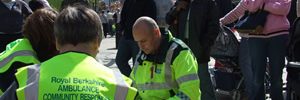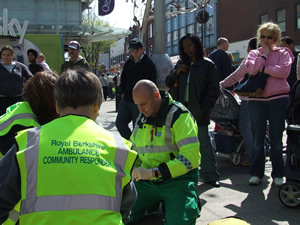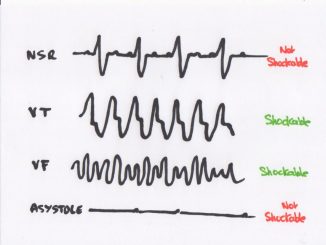Here we answer questions that you may have about using a defibrillator. If you have never been trained to use one, they can be very scary bits of equipment “What if I kill the patient?” “Will I get a shock?” “Will they sue me?”. Defibrillators are appearing all over the place in the guise of “Public Access Defibrillators” (“PADs”). Surely if anyone can access them, then they must be safe?
There are many brands of Defibrillator on the Market, but the principles of operating a Publicly Accessible one remain the same.
Instructions on using a Defibrillator
Here are the comprehensive instructions on how to use one.
If you have one, switch it on, listen to and follow the instructions.
That’s it. Seriously. These devices have been designed to be as safe as possible. Anyone can use one, you do not need to be specifically trained. Still not convinced? OK, let’s break the process down to convince you.
Step 1 – switch it on. Sometimes there is a Power button. Press and hold. If there is not a power button, open the cover. This automatically switches it on.
Step 2 – self test. The defibrillator will run through a few self checks. These do not take long. Whilst it is doing this, you can spend the time exposing the patient’s chest. The defibrillator pads have to stick to bare skin, so any clothing on the chest needs to be pushed to one side or cut off. This includes a bra if the patient is wearing one – you are trying to save the person’s life, at this point dignity is not an issue.
Step 3 – peel off the backing and stick the pads to the chest as shown on the pictures on the pads themselves and possibly also the defibrillator.
Step 4 – the defibrillator will now automatically analyse the rhythms that it finds and make a decision whether or not to shock. You do not need to make that decision.
Step 5 – if the defibrillator decides that the patient can be shocked, it will ask you to ensure that no-one is touching the patient then tell you to press the Shock Button. Press it.
Step 6 – whether or not it shocks, if there are no signs that the patient is breathing then go back to carrying out CPR.
Some notes
- The defibrillator is in charge. Listen to what it says
- If it decides not to shock, you haven’t done anything wrong
- Even with a defibrillator, the probability of surviving a Cardiac Arrest outside hospital is slim. By using one, even if it doesn’t shock, you have given that patient the best chance of survival
- They are effectively dead. You are not going to make them worse, but you might make them better
- Shocking them with a defibrillator is no guarantee of survival, but it is their best chance





Be the first to comment